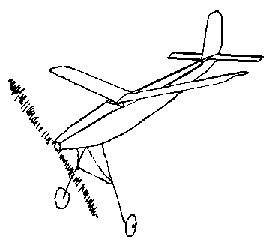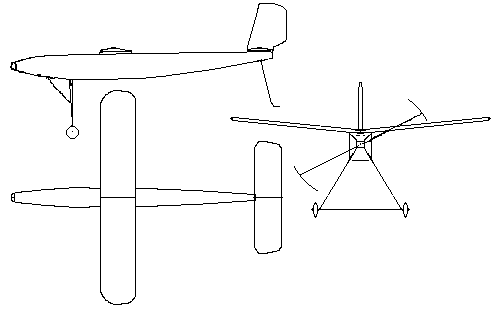Wakefield International Cup - A history from 1911 by Charles Dennis Rushing
1930 Joseph Ehrhardt, 18, USA
The third Wakefield International Cup contest was again held at Halton, Aerodrome, England, on Saturday, July 19th. Again this year three Americans came to England, having won the US Nationals Grand Prizes of all expenses paid trips to Europe, but this time, they came with Wakefields to compete against the five man Team GB, and Team Canada. The Americans were Ray Thompson, Bill Chaffee, and Joe Ehrhardt, who were flying all balsa wood Wakefields weighing about 4 ounces including the T-56 brown rubber motors of 10 strands 1/8"x 1/30". These motors were usually wound up from 1100 to 1200 turns, providing a 60 second motor run, using a 17" diameter propeller with 28" of pitch. Joe Ehrhardt used a modified NACA 6409 airfoil on a wing of 32" span. Contrast these Wakefields with those flown by Team GB, which were considered to be light if they weighed in at 9 ounces! These English Wakefields were made of hard woods, steel wire, and were covered with silk. The configuration of these Team GB Wakefields may have been low winged, with an area of about 200 square inches, following the pattern set by R N Bullock, the 1929 Wakefield Champion, who was on hand to defend his title.
What happened on Saturday to Team GB is best left to Pelly-Fry who was quoted in the September 1982 AeroModeller as saying: "The American (Joe Ehrhardt) ended up by walking off with first place to the tune of 155 seconds ROG, that made us sit up and take notice! (of balsa wood) This same article indicates what some aeromodellers in Great Britain thought balsa wood ".. has no strength, and can only be used for unimportant parts." This attitude prevailed into 1931, and continued well into the late years of the decade. By 1995 balsa wood was obsolete as a major component construction material, and many balsa wood Wakefields had simply become "uncompetitive". Mark Haas, an American Boy staff member tells the story this way: "We were ready for any kind of weather, and we got every kind. The Wakefield Contest was held in conjunction with the annual Halton Aerodrome Exhibition, so there were thousands of spectators. It did my soul good to hear the British entries complaining about the weather, for I knew that if we won there would be no qualifying adjectives applied to our victory. 'Beastly weather, by Jove,' they said. 'I say, a wicked day!' And we agreed - it was a real test for the models. Occasional rain, a wind that jabbed instead of blowing steadily. Gusts that would blow a plane over before it could get enough power to flight.
A British entry made the first trial and flipped over before it left the runway. We insisted that this be called a 'no flight', for he hadn't had a chance to test conditions. His next try was more successful - he made 35 seconds. Joe Ehrhardt flew next. He had decided to use the same plane that had won the AMLA (Nationals) Contests three weeks before, though he had extra wings and props and fuselage ready. His plane weighed about 3 ounces- that first British ship weighed 10! But Joe's ship had power, as was shown when it held it's own against the strongest wind of the day. His first flight was 64 seconds. The (next) British entry - the Captain of the British Team - made Joe's flight look weak, though. He made 84 seconds. Applause and yells from the sidelines - excited announcements from the loud speakers - congratulations from us.
Joe wasn't bothered a bit. He knew his plane could do close to three minutes, and he knew just why it hadn't done it on that first flight (a knot of rubber prevented the motor from unwinding; the plane came down dead stick with a third of the turns [unused] still in the motor). Let me say right now that Joe Ehrhardt didn't win any contests on luck or somebody else's reputation. He knows aerodynamics from birth to the grave ( ! ? ). He was the chairman of our speaking committee whenever anybody wanted to talk aviation.
Flights continued. Bill Chaffee did 26.6 seconds, which was good enough to get him sixth place. Ray Thompson did 37 seconds, but the flight was disqualified because he accidentally pushed his plane in launching. But the wind and not the judges gave Ray the count, for he picked up his ship with a dustpan. Bill did the same thing on his next flight. But in the meantime Joe's turn came again and he had three minutes written all over his face. He had so much power in his ship that it went almost straight up - snickered at the wind - then lit out for points north. His official time was 155 seconds. England had seen its best fuselage flight, and the crowd certainly appreciated it." Joe Ehrhardt of St Louis, Missouri was the 1930 Wakefield International Cup Champion, the first American to win the "Ole Mug." He was a child, 18 years of age.

| WINNING WAKEFIELD | ||
| component | inches | mm |
| wing | 32x4 | 813x102 |
| stabilzer | 17.5x2.875 | 445x73 |
| fuselage | 30 | 762 |
| propellers | 17 dia x 28 pitch | 432 dia x 711 pitch |
| rubber | T-56 1/8" | T-56 3mm |

References
American Boy, Sept 1930
Aeromodeller, Aug 1982, Vintage Corner, Alex Imrie
Aeromodeller, Sept 1982, Vintage Corner, Alex Imrie
Music: "I got rythm"; Literature: "Cimarron", Cine: "Das Angels Blue"

